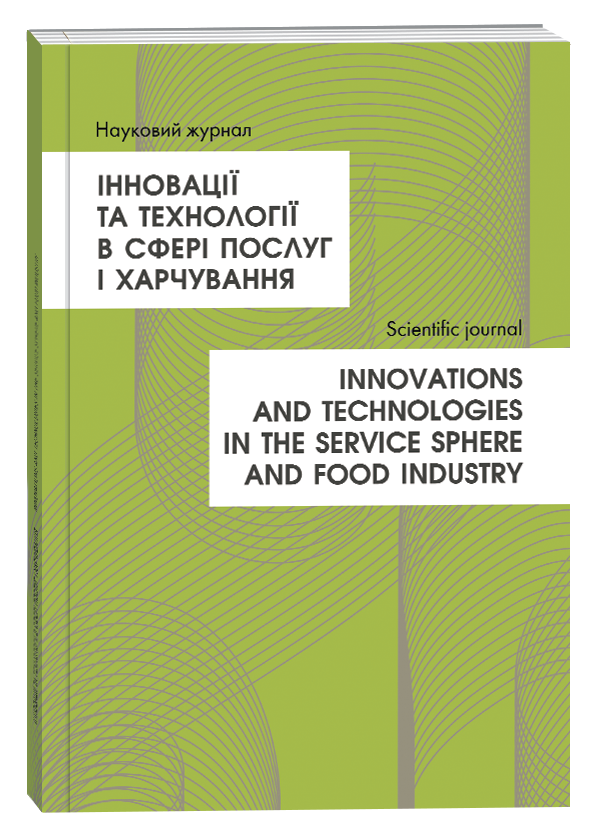FEATURES OF USING MOBILE APPLICATIONS IN ORGANIZING AND CONDUCTING EXCURSIONS
Abstract
The article highlights the peculiarities of using mobile applications in organizing and conducting excursions. It is noted that one of the main advantages of mobile applications for sightseeing tourism is that they can provide tourists with access to information about attractions and routes. It has been established that some of the most popular mobile applications for sightseeing tourism are TripAdvisor, Viator, Guided Tours, Citymapper. It has been found that the main features of using mobile applications in sightseeing tourism include mobility, information, interactivity, and personalization. It has been found that mobile applications can be used in various areas of sightseeing tourism, including travel agencies, museums and historical sites, and tour guides. It is determined that the use of mobile applications in excursion tourism has a number of advantages, including improving the quality of tourist services, increasing the number of tourists, reducing the cost of tourist services. It is noted that the use of mobile applications in sightseeing tourism has some disadvantages, in particular, insufficient information content, insufficient interactivity, insufficient personalization. It has been established that mobile applications should be informative, interactive and personalized, as well as accessible to a wide range of tourists, regardless of their interests, language and age. The main advantages of using mobile applications when leading a tour are improved spatial orientation, increased information that can be provided to tourists, and making the tour more interactive and engaging. It has been found that mobile applications are an effective tool that can be used to improve the efficiency and quality of guided tours. It has been established that mobile applications contribute to the gradual digitalization of the entire tourism industry, which allows to abandon traditional media. The advantages of using mobile applications in tourism are highlighted. The difficulties and problems of using mobile applications from the point of view of the industry and the consumer are highlighted.
References
Білозубенко В., Разінькова М., Небаба Н., Ятчук О. Комунікаційні та інформаційні технології в туризмі: теоретикометодичний аспект. Вісник Київського національного університету технологій та дизайну. Серія «Економічні науки». 2020. № 3(147). С. 48 56.
Григор’єва С. Lviv City Card виповнився перший рік: найпопулярніші картки і топ атракції. Львівська міська рада. 2019. URL: https://city-adm.lviv.ua/news/tourism/271555-lviv-city-card-vypovnyvsia-pershyi-rik-naipopuliarnishi-kartky-i-top-atraktsii
Гудима Ю. GPS: нові горизонти в туристичній справі. Карпати. 2005. Вип. 1(3). URL: http://www.karpaty.net.ua/arkhiv/2005-rik/13-1-3-zyma2004-2005-rr/58-gps-novi-horyzonty-v-turystychnii-spravi
Дащук Ю.Є., Лепкий М.І. Досвід використання SMART-технологій в управлінні туристичним продуктом міста. Приазовський економічний вісник. 2019. Вип. 3(14). С. 294 298.
Концепція «Київ Смарт Сіті 2020». Смарт Сіті – Стратегія Розвитку Міста XXI століття. 2017. URL: https://ips.ligazakon.net/document/view/MR171881?an=7&ed=2017_11_21
Мельниченко С., Єсипова К. Інтернет-технології в діяльності туристичних підприємств. Вісник КНТЕУ. 2010. Вип. 6. С. 35 47.
Мешко Н., Фалько Є. Розвиток туристичного бізнесу в умовах інформатизації світової економіки. Глобальні та національні проблеми економіки. 2014. № 2. С. 114–120.
Пасічник В.В., Артеменко О.І., Попик І.В. Геоінфрмаційні технології, зорієнтовані на потреби туриста. Cучасні особливості формування і управління інноваційним потенціалом регіонального розвитку туризму та рекреації із залученням молодіжного ресурсу: матеріали міжнародної науково-практичної конференції (15−17 жовтня 2015 р.). Тернопіль: ТНТУ, 2015. С. 238−241.
Citymapper. URL: https://citymapper.com
Hrabar M., Kashka M. Influence of mobile applications on tourism. The Potential of Modern Science: collective monograph. Volume 2. London: Sciemcee, 2019. P. 83−94.
Hrabar M., Kashka M. Tourist internet advertising: current state and trends of development. Social and legal aspects of the development of civil society institutions: collective monograph. Part I. Warsaw: BMT Erida Sp.z o.o., 2019. P. 61−76.
SmartGuide: Digital Tour Guide. URL: https://play.google.com/store/apps/details?id=org.smart_guide.smartguide.T_00007&hl=en_US
Tripadvisor. URL: https://www.tripadvisor.com/
Bilozubenko V., Razinkova M., Nebaba N., Yatchuk O. (2020) Komunikatsiini ta informatsiini tekhnolohii v turyzmi: teoretykometodychnyi aspekt [Communication and information technologies in tourism: theoretical and methodological aspect]. Visnyk Kyivskoho natsionalnoho universytetu tekhnolohii ta dyzainu. Seriia «Ekonomichni nauky», no. 3(147), pp. 48 56.
Hryhorieva S. (2019) Lviv City Card vypovnyvsia pershyi rik: naipopuliarnishi kartky i top atraktsii [Lviv City Card has completed its first year: the most popular cards and top attractions]. Lvivska miska rada. Available at: https://city-adm.lviv.ua/news/tourism/271555-lviv-city-card-vypovnyvsia-pershyi-rik-naipopuliarnishi-kartky-i-top-atraktsii
Hudyma Yu. (2005) GPS: novi horyzonty v turystychnii spravi [GPS: new horizons in tourism. Carpathians]. Karpaty, no. 1(3). Available at: http://www.karpaty.net.ua/arkhiv/2005-rik/13-1-3-zyma2004-2005-rr/58-gps-novi-horyzonty-v-turystychnii-spravi
Dashchuk Yu. Ye., Lepkyi M. I. (2019) Dosvid vykorystannia SMART-tekhnolohii v upravlinni turystychnym produktom mista [Experience of using SMART technologies in the management of the tourist product of the city]. Pryazovskyi ekonomichnyi visnyk, no. 3(14), pp. 294 298.
Kontseptsiia «Kyiv Smart Siti 2020». Smart Siti – Stratehiia Rozvytku Mista XXI stolittia ["Kyiv Smart City 2020" concept. Smart City – City Development Strategy of the 21st century]. (2017). Available at: https://ips.ligazakon.net/document/view/MR171881?an=7&ed=2017_11_21
Melnychenko S., Yesypova K. (2010). Internet-tekhnolohii v diialnosti turystychnykh pidpryiemstv [Internet technologies in the activity of tourist enterprises]. Visnyk KNTEU, no. 6, pp. 35 47.
Meshko N., Falko Ye. (2014) Rozvytok turystychnoho biznesu v umovakh informatyzatsii svitovoi ekonomiky [Development of tourism business in the conditions of informatization of the world economy]. Hlobalni ta natsionalni problemy ekonomiky, no. 2, pp. 114–120.
Pasichnyk V. V., Artemenko O. I., Popyk I. V. (2015) Heoinfrmatsiini tekhnolohii, zoriientovani na potreby turysta [Geoinformation technologies oriented to the needs of tourists]. Cuchasni osoblyvosti formuvannia i upravlinnia innovatsiinym potentsialom rehionalnoho rozvytku turyzmu ta rekreatsii iz zaluchenniam molodizhnoho resursu: materialy mizhnarodnoi naukovo-praktychnoi konferentsii (15−17 zhovtnia 2015 r.). Ternopil: TNTU, pp. 238−241.
Citymapper. Available at: https://citymapper.com
Hrabar M., Kashka M. (2019) Influence of mobile applications on tourism. The Potential of Modern Science: collective monograph. Vol. 2. London: Sciemcee, pp. 83−94.
Hrabar M., Kashka M. (2019) Tourist internet advertising: current state and trends of development. Social and legal aspects of the development of civil society institutions: collective monograph. Vol. I. Warsaw: BMT Erida Sp.z o.o., pp. 61−76.
SmartGuide: Digital Tour Guide. Available at: https://play.google.com/store/apps/details?id=org.smart_guide.smartguide.T_00007&hl=en_US
Tripadvisor. Available at: https://www.tripadvisor.com/



